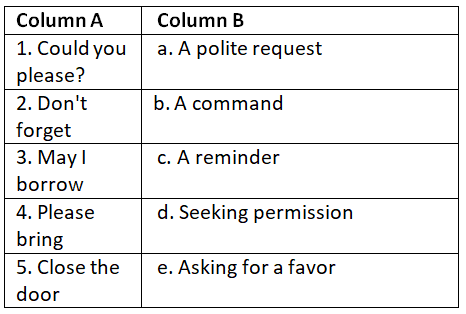Worksheet: Commands and Requests | English Grammar Advanced - Class 10 PDF Download
| Table of contents |

|
| Section A: Multiple Choice Questions |

|
| Section B: Short Questions |

|
| Section C: Fill in the Blanks |

|
| Section D: Match the Column |

|
| Section E: True or False |

|
Section A: Multiple Choice Questions
Q.1. Which of the following is the correct definition of a command?
(a) A polite way to ask someone to do something.
(b) A statement that expresses a strong request or directive.
(c) A sentence that ends with a question mark.
(d) A type of question that seeks information.
Q.2. What is the main difference between a command and a request?
(a) A command is more polite than a request.
(b) A request is a question, whereas a command is a statement.
(c) A command is a directive, whereas a request seeks cooperation.
(d) There is no difference; the terms can be used interchangeably.
Q.3. Which of the following sentences is an example of a command?
(a) Could you please pass the salt?
(b) Can you tell me the time?
(c) Shut the door before leaving.
(d) Would you like a cup of tea?
Q.4. In a command, the subject of the sentence is usually ___________.
(a) You
(b) I
(c) They
(d) He/She
Q.5. Which punctuation mark is typically used at the end of a command?
(a) Period (.)
(b) Comma (,)
(c) Exclamation mark (!)
(d) Question mark (?)
Section B: Short Questions
Q.1. Define a request in the context of communication.
Q.2. Give an example of a command that can be used in a classroom setting.
Q.3. Explain the importance of using polite language while making requests.
Q.4. What is the role of body language in conveying commands effectively?
Q.5. How can commands and requests be used to establish authority and influence?
Section C: Fill in the Blanks
Q.1. A command is a type of _______ that expresses a request or directs someone to do something.
Q.2. In a command, the subject is usually _______.
Q.3. A command usually ends with a _______.
Q.4. A _______ command is a polite way of making a request or giving an order.
Q.5. A _______ command is a direct and forceful way of giving an order or making a request.
Section D: Match the Column
Match the words/phrases in Column A with their corresponding meanings in Column B.
Section E: True or False
Q.1. A command always ends with an exclamation mark.
Q.2. An indirect command is a more polite way of giving an order.
Q.3. The subject of a command is always explicitly stated.
Q.4. "May I have some water, please?" is an example of an imperative command.
Q.5. "Stop talking!" is an example of an imperative command.
You can access the solutions to this worksheet here.
|
53 videos|210 docs|40 tests
|
FAQs on Worksheet: Commands and Requests - English Grammar Advanced - Class 10
| 1. What are the main sections included in the Commands and Requests worksheet? |  |
| 2. How can I prepare effectively for the Commands and Requests exam? |  |
| 3. Are there specific strategies for answering multiple choice questions in the exam? |  |
| 4. What types of short questions can I expect in the Commands and Requests section? |  |
| 5. How are the fill in the blanks and match the column sections structured in the worksheet? |  |















